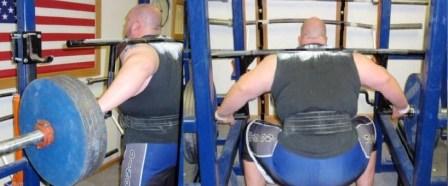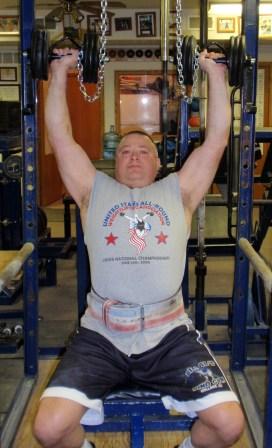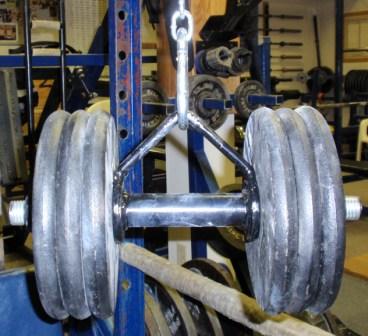by Al Myers

Scott Tully, of the Dino Gym, training with a Cambered Squat Bar. In this picture Scott is squatting 520 pounds for reps.
I have made lots of interesting training devices for the Dino Gym. Some are of my original design while others I copied from someone else. Some get used all the time, while others just get “pulled out” every now and then. Some of the devices are for very specific-type training, while others are used for general strength training. A few weeks ago Dino Gym member Scott Tully started using the cambered squat bar for his squat workouts. I made this bar several years ago after reading about its advantages described by Dave Tate of Elite Fitness Systems. It has been around, or on the market, for several years now. The first time I had ever heard of a cambered squat bar was in an article by Louie Simmons of Westside Barbell. Most people attribute the development of the cambered squat bar to Louie. This bar has been hanging in the bar rack in the gym for quite a while so I was glad to see Scott pull it out and put it to use. Sometimes just changing things up in your training will jump-start your strength gains. I’m sure that is why Scott decided to use this bar in his training program – and he probably will only use it a few weeks before resuming straight bar squats. And I predict once he gets back on the straight bar squats – his squat will be improved.
It was pretty easy to make, but did require the sacrifice of two good bars to make one unusual looking one. The main benefit of squatting with the cambered bar is to decrease the stress on the upper back and place more muscular involvement in the hips and legs. The experts say it strengthens the posterior chain (which I say is a fancy word for the gluteus maximus. haha look THAT one up!). The camber (or offset) is 14 inches. As you descend into a squat with this bar the weight “tracks” in a different line compared to a straight bar. The result of this is that you will squat more upright with the cambered squat bar. Also, by being able to grip it lower, using a cambered squat bar greatly reduces the stress on the shoulders and elbows. It is perfect if you are “coming back” from a shoulder injury where your shoulder mobility is reduced or painful when gripping a straight squat bar.
This bar is also rackable – meaning you can take it out and return it to normal bar hooks in a cage or squat rack. Spotting someone using this bar is no different than a normal bar. The upper portion of the bar exceeds the racking hooks far enough that you can get a hold of it during a spot if needed. I sort of have problems calling this bar a cambered bar, because in my mind “camber” means bent. Like a Buffalo Bar or Bill Clark’s “special” one handed deadlift bar. Webster’s dictionary defines camber as “a slight curve” or “to arch slightly”. This bar SHOULD be called an off-set bar instead. But it has been advertised as a cambered bar for so long now, that name has stuck. However, it is a great addition to any gym and adds variety to any strength training program.


